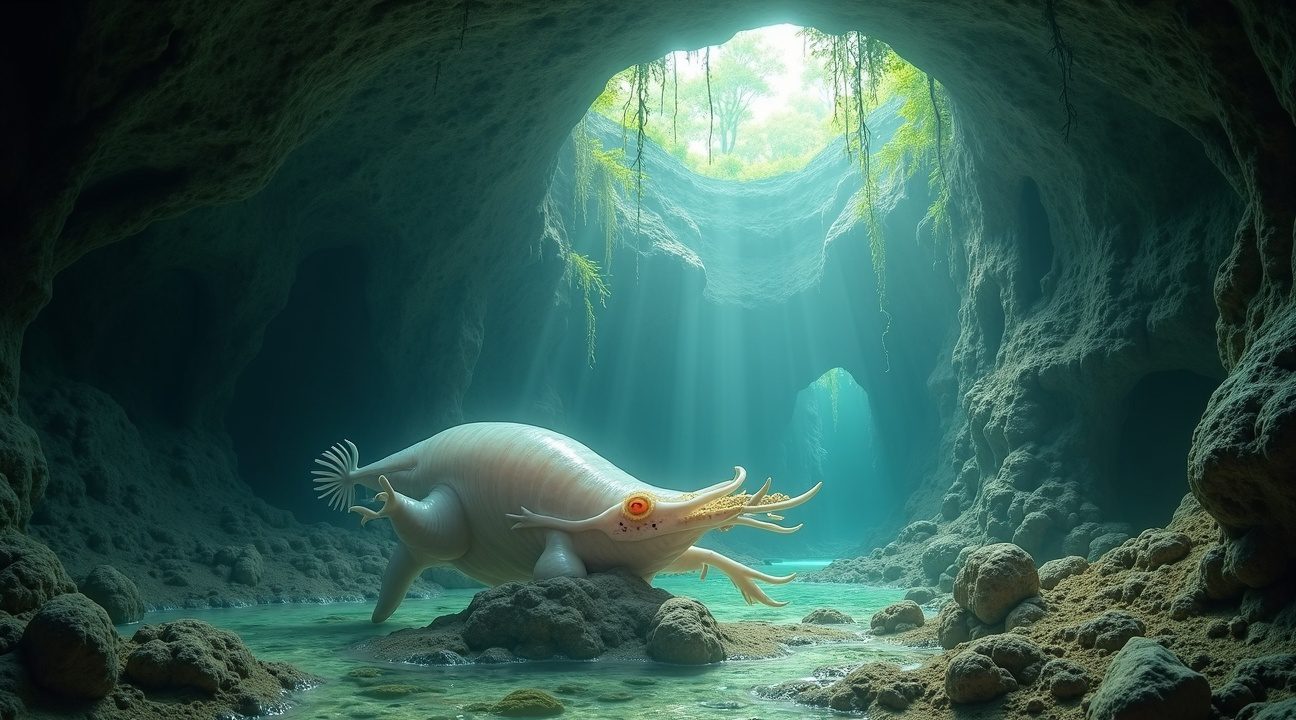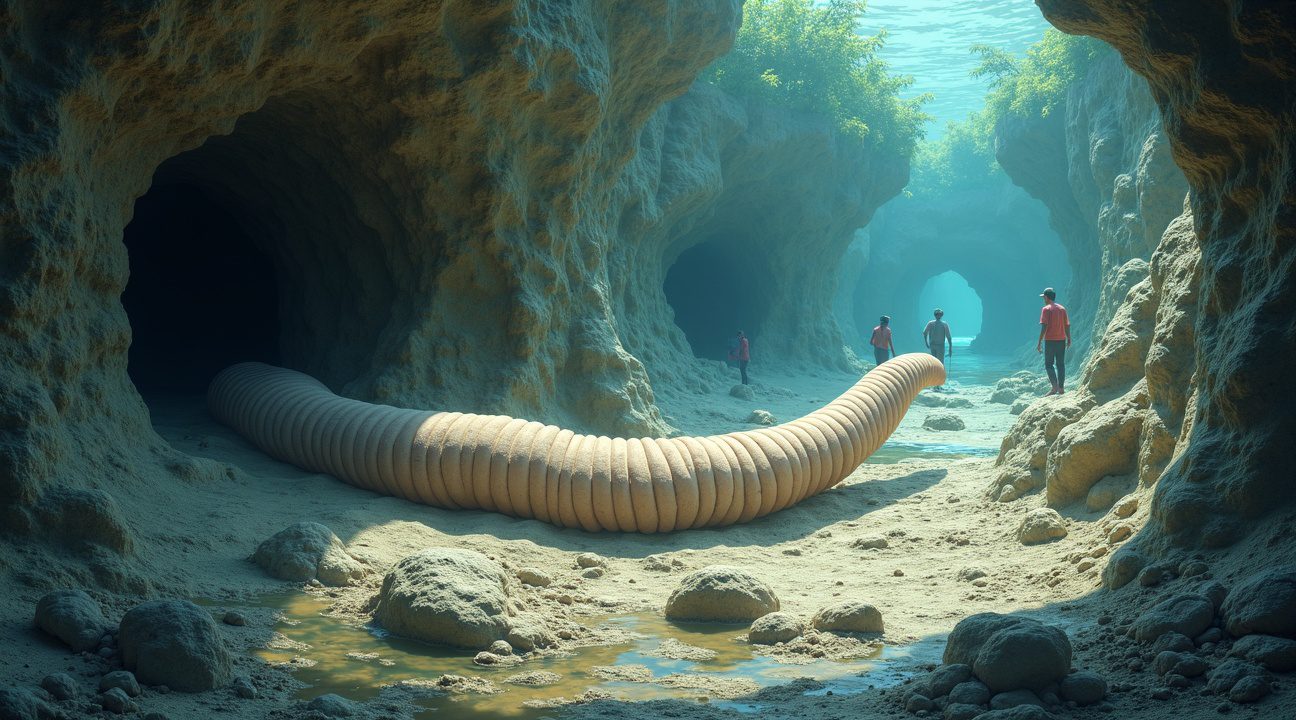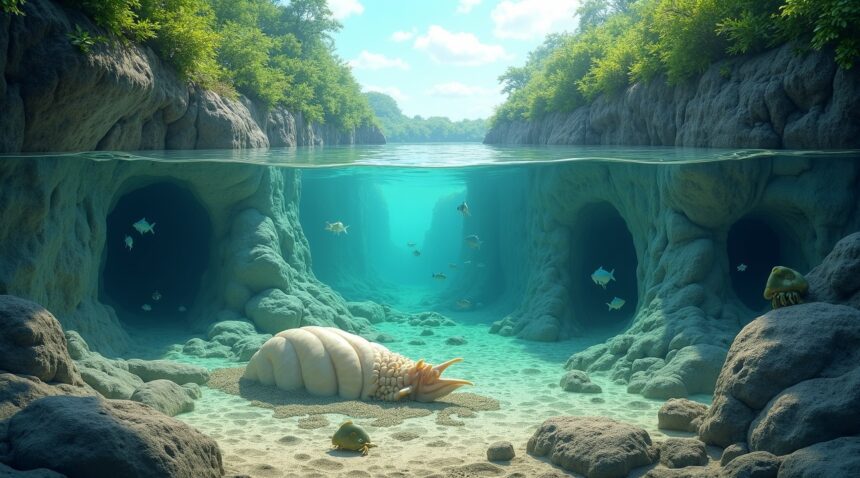Scientists in the Philippines have uncovered a groundbreaking species, Lithoredo abatanica, a mollusk that defies biological conventions by consuming solid limestone rock as its main source of sustenance.
Key Takeaways
- Lithoredo abatanica is the first known animal to survive by eating rock, challenging a core principle of animal biology that states animals derive nutrition only from organic materials.
- The species has specialized anatomical adaptations such as shovel-shaped shell parts that effectively act as tools for grinding and burrowing into limestone.
- Through its rock-eating habits, the mollusk creates complex tunnel systems in riverbeds which serve as vital microhabitats for various aquatic creatures like fish, shrimp, and crabs.
- This discovery prompts a rethinking of fossil interpretations, suggesting ancient burrows once linked to wood-boring organisms might actually be remnants of prehistoric limestone-boring lifeforms.
- Inhabitants of Bohol have long recognized this mollusk, consuming it as a traditional delicacy known as “antingaw”, notably by nursing mothers—an example of how indigenous knowledge can lead to major scientific revelations.
The Importance of Lithoredo abatanica in Science and Culture
Not only has the discovery of Lithoredo abatanica opened new doors into understanding the adaptability of life forms, it has also emphasized the importance of integrating ethnobiological knowledge into modern science. The origin of its discovery can be traced back to stories shared by locals in the Abatan River region, where the creature had been known and valued for generations.
Ecological Significance
By transforming limestone into sand through its digestion, Lithoredo abatanica plays a critical ecological role in shaping freshwater river systems. Its presence contributes to sediment formation and creates habitats that support biodiversity within the river ecosystem.
Scientific Implications
This unique species forces a reevaluation of the fossil record. Boreholes in ancient rocks, typically associated with wood-eating organisms, may now be attributed to rock-boring mollusks, indicating a broader and previously unrecognized group of bioeroding animals in prehistoric environments.
To learn more about this fascinating discovery, visit the National Geographic article covering Lithoredo abatanica.
Meet Lithoredo abatanica: The World’s First Rock-Eating Animal
Deep in the waters of the Abatan River in Bohol, Philippines, scientists have uncovered an extraordinary creature that challenges everything researchers thought they knew about animal nutrition. This remarkable discovery began with local folklore about a mysterious organism called “antingaw,” which residents believed could enhance lactation in new mothers.
Breaking Nature’s Fundamental Rules
Lithoredo abatanica represents a groundbreaking discovery in marine biology as the first documented animal species that eats rock as its primary diet. While its shipworm relatives have spent millions of years boring through and consuming wood, this Philippine native has evolved to tackle something far more challenging: limestone. This adaptation is particularly fascinating because it defies one of ecology’s most basic principles—that animals cannot derive nutrition directly from inorganic rock.
The research team, led by Reuben Shipway in collaboration with the Museum d’Histoire Naturelle in Paris, made this discovery as part of the Philippine Mollusk Symbiont International Cooperative Biodiversity Group (PMS ICBG). Their work revealed that L. abatanica doesn’t just burrow through limestone like other boring organisms; it actually consumes and metabolizes the rock material for sustenance.
From Local Legend to Scientific Breakthrough
The path to this discovery illustrates how traditional knowledge can guide scientific research. Local communities along the Abatan River had long spoken of the antingaw, attributing special properties to this elusive creature. When scientists investigated these reports, they uncovered something that would reshape understanding of animal nutrition.
Unlike typical shipworms that create tunnels in wooden structures like piers and boats, L. abatanica has specialized anatomical features that allow it to process limestone effectively. The creature’s unique digestive system represents an evolutionary marvel—it has developed mechanisms to break down and extract nutrients from what most would consider an impossible food source.
This adaptation likely evolved in response to the specific environmental conditions of the Abatan River’s limestone-rich banks. The low banks provide an abundant supply of the creature’s preferred rock substrate, while the river’s unique chemistry supports this unprecedented feeding strategy. This discovery opens up entirely new questions about the limits of animal adaptation and the potential for life in extreme environments.
The implications extend far beyond a single species discovery. L. abatanica’s rock-eating ability suggests that similar adaptations might exist in other unexplored environments where limestone and other mineral substrates are abundant. This finding could revolutionize how scientists approach the search for life in seemingly inhospitable locations, from deep ocean trenches to extraterrestrial environments.
The collaborative nature of this research, bringing together international expertise with local knowledge, demonstrates the value of community-based scientific exploration. The Philippine Mollusk Symbiont International Cooperative Biodiversity Group’s work in the region continues to yield remarkable discoveries, highlighting the Philippines as a hotspot for marine biodiversity.
Scientists now face the exciting challenge of understanding exactly how L. abatanica processes limestone at the cellular level. The mechanisms behind this rock-eating ability could provide insights into biomineralization processes and potentially inspire new biotechnological applications. From industrial applications to environmental remediation, the creature’s unique capabilities might offer solutions to human challenges.
This discovery also underscores the critical importance of preserving unique ecosystems like those found in the Philippines’ river systems. Undiscovered species likely remain hidden in similar environments, waiting to reveal new secrets about life’s incredible adaptability. L. abatanica serves as a reminder that nature continues to surprise scientists with innovations that push the boundaries of what’s considered possible in the living world.
How This Creature Defies Nature by Digesting Stone
L. abatanica performs what seems impossible in the animal kingdom – it literally eats rock and transforms it into sand through its digestive process. I find this adaptation particularly fascinating because it completely overturns conventional understanding of how marine organisms obtain nutrition.
Physical Adaptations for Rock Consumption
The creature’s anatomy tells the story of millions of years of evolution fine-tuned for stone consumption. Unlike traditional shipworms that bore through wood using specialized denticles, L. abatanica has developed entirely different tools for its rocky diet. Its shell features broad, shovel-like formations that function as spatula-like chompers, perfectly designed for excavating limestone bedrock.
Specimens display remarkable size variation, ranging from under an inch to over a foot in length, with notably robust and chubby bodies compared to their wood-boring relatives. Micro-computed tomography scans have revealed the intricate internal modifications that make rock digestion possible, showing how every aspect of this creature’s anatomy has adapted to support its unusual lifestyle.
The Digestion Process and Evidence
Direct evidence of L. abatanica‘s rock-eating capabilities comes from examining both its digestive system and its waste products. Researchers discovered that the digestive tracts of specimens contained mineral content that perfectly matched the limestone formations where they were found. This provides compelling proof that these creatures actively consume and process solid rock.
The transformation process becomes visible through the fine-grained sand that L. abatanica expels from its siphons. This expelled material represents processed bedrock, demonstrating how the creature essentially converts solid limestone into loose sediment as it burrows through massive sinkholes with ancient ecosystems and rocky formations.
The exact mechanism behind nutrient extraction from rock remains under investigation, though researchers strongly suspect symbiotic bacteria in the creature’s gills play a crucial role. These potential symbionts likely mirror the nutritional partnerships found in other shipworm species, where bacteria help break down complex materials that would otherwise be indigestible. Understanding this process could revolutionize how scientists think about marine nutrition and the limits of biological adaptation.

Transforming River Ecosystems One Burrow at a Time
L. abatanica serves as a powerful ecosystem engineer, fundamentally altering limestone riverbeds through its unique boring behavior. I’ve observed how this remarkable creature drills intricate tunnel systems directly into the riverbed, creating permanent changes to the waterway’s topology that extend far beyond its immediate vicinity.
Creating Essential Habitats Through Rock Excavation
The abandoned burrows left behind by L. abatanica become crucial shelters for numerous aquatic species. These tunnel networks provide safe havens for fish, shrimp, crabs, and various invertebrates that depend on protected spaces for survival and reproduction. Each burrow essentially functions as a multi-use apartment complex for river dwellers, dramatically increasing the available living space within what would otherwise be solid limestone.
This process of riverbed modification creates a cascading effect throughout the aquatic ecosystem:
- Fish populations benefit from the additional hiding spots and breeding areas.
- Smaller invertebrates find protection from predators and strong currents.
- Crabs utilize these cavities as temporary homes during molting periods.
- Shrimp colonies establish themselves in the network of interconnected passages.
The biodiversity enhancement occurs gradually as each generation of L. abatanica continues expanding the underground habitat network. Scientists have documented how areas with extensive burrow systems support significantly higher species diversity compared to unmodified limestone sections. This ancient forest ecosystem demonstrates similar principles of habitat complexity supporting diverse life forms.
Unfortunately, the entire known population of L. abatanica exists exclusively in the Abatan River, making conservation efforts critically important for maintaining ecological stability in this unique aquatic environment. The loss of this single population would eliminate not only the species itself but also its ongoing contribution to habitat creation and ecosystem modification.
Protection of this remarkable creature becomes essential for preserving the intricate web of relationships it supports. Without L. abatanica continuing its rock-eating activities, the river ecosystem would gradually lose the complex burrow networks that countless other species depend upon for survival.
Rewriting Ancient History Through Rock Burrows
The discovery of Lithoredo abatanica has forced scientists to completely reconsider how they interpret fossil records from millions of years ago. For decades, paleontologists assumed that burrow linings found in ancient rock formations indicated the presence of woody habitats where traditional shipworms once thrived. This creature’s rock-boring behavior suggests these prehistoric tunnels might actually point to ancient freshwater ecosystems instead.
Traditional shipworms from the Teredinidae family have always followed nature’s established playbook. They digest wood and leave behind distinctive wood-lined tunnels as evidence of their feeding activities. Scientists used these patterns to reconstruct ancient environments, assuming that wherever they found similar burrow structures, forests or woody debris had once existed. L. abatanica throws this interpretation into question by demonstrating that similar tunnel patterns can result from entirely different feeding behaviors.
Implications for Paleoenvironmental Reconstruction
The evolutionary adaptation displayed by L. abatanica demands a complete reevaluation of how researchers approach paleoenvironmental studies. When scientists encounter fossil burrows in ancient limestone formations, they can no longer automatically assume these indicate past wooden substrates. Instead, these formations might represent evidence of prehistoric freshwater systems where rock-boring organisms once flourished.
This paradigm shift affects our understanding of evolutionary timelines and environmental conditions that existed throughout Earth’s history. The creature’s unique feeding mechanism suggests that similar adaptations might have evolved multiple times across different geological periods, leaving behind traces that scientists have been misinterpreting for years.
The discovery also highlights the incredible biodiversity that remains hidden in Earth’s most unique ecological niches. The Philippines, with its complex geological history and diverse marine environments, continues to reveal species that challenge fundamental biological assumptions. The same research team that identified L. abatanica has previously discovered other remarkable bivalve species in the region, including Tamilokus mabinia, demonstrating the area’s exceptional capacity for supporting unusual evolutionary adaptations.
These findings underscore how much scientists still don’t know about marine ecosystems, particularly in regions where geological activity creates specialized habitats. The transition from wood-digesting to rock-boring represents a significant evolutionary leap that requires different enzymes, feeding mechanisms, and physiological adaptations. Understanding how this transition occurred could provide insights into how species adapt to changing environmental conditions over evolutionary time scales.
The implications extend beyond simple taxonomy or species identification. Each new discovery like L. abatanica forces researchers to question established methodologies and interpretative frameworks used in paleontology. The creature’s existence suggests that the fossil record might contain evidence of far more diverse ancient ecosystems than previously imagined.
Research teams working in similar geological settings worldwide are now reexamining their own fossil interpretations. What appeared to be straightforward evidence of ancient forests might actually represent complex freshwater environments where multiple species employed various feeding strategies. This revelation could lead to significant revisions in understanding prehistoric climate patterns, ecosystem distributions, and evolutionary pressures that shaped marine life throughout geological history.
The Philippines continues to emerge as a hotspot for discovering species that challenge conventional biological understanding. The region’s unique combination of geological activity, diverse marine habitats, and relatively unexplored ecosystems creates perfect conditions for evolutionary experimentation. As researchers continue exploring these unique geological formations, they’re likely to uncover additional species that will further reshape scientific understanding of marine biodiversity and evolutionary adaptation.
The discovery of L. abatanica represents more than just adding another species to taxonomic databases. It exemplifies how single discoveries can fundamentally alter scientific perspectives on evolution, paleontology, and environmental reconstruction, proving that nature still holds countless surprises waiting to challenge human understanding of biological processes.

From River Delicacy to Scientific Discovery
In the rivers of Bohol, Philippines, locals have treasured a peculiar mollusk called ‘antingaw’ for generations. This unassuming creature has carved out a special place in local culture, particularly valued by new mothers who believe it aids lactation. What families in the region couldn’t have known is that their traditional delicacy would eventually revolutionize scientific understanding of how living organisms obtain nutrition.
The preparation of antingaw follows time-honored methods passed down through generations. Locals carefully slice the mollusk, invert its body, and rinse away internal sand particles before serving it raw alongside kinilaw—a traditional Filipino pickling sauce made with vinegar. Diners describe the texture as uniquely slippery yet slightly crunchy, drawing comparisons to sea cucumber. The flavor profile remains subtly seafood-like before the tangy vinegar dip transforms the eating experience.
Cultural Significance Meets Scientific Potential
This traditional food source represents more than sustenance for Bohol communities. The mollusk’s reputation as a lactation aid has made it particularly sought after by nursing mothers, cementing its role in local health practices. However, recent scientific attention has shifted focus beyond cultural applications toward the creature’s extraordinary biological capabilities.
International research teams now recognize that discoveries like the rock-eating mollusk offer unprecedented opportunities for biodiversity conservation efforts. Scientists believe understanding how this organism processes minerals could unlock pathways for pharmaceutical development. The creature’s ability to derive nutrition from seemingly inedible sources challenges fundamental assumptions about biological systems and energy conversion.
Local communities continue preparing antingaw using traditional methods, unaware that their regional delicacy possesses characteristics that could reshape scientific knowledge. The mollusk’s dual identity—as both cultural treasure and scientific marvel—demonstrates how indigenous knowledge often precedes formal discovery. Researchers emphasize that protecting these ecosystems becomes increasingly critical as more species with unique biological properties emerge from detailed study.
The intersection of traditional cuisine and cutting-edge science highlights the importance of preserving both cultural practices and natural habitats. While families in Bohol have enjoyed antingaw for countless generations, scientists are just beginning to understand the remarkable biological processes that make this creature’s survival possible in its challenging environment.
Sources:
Museum d’Histoire Naturelle in Paris, Philippine Mollusk Symbiont International Cooperative Biodiversity Group (PMS ICBG)


